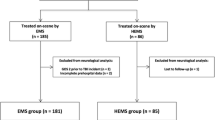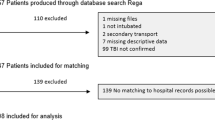Abstract
Background
Prehospital endotracheal intubation (PEI) of head injured children with impaired level of consciousness (LOC) aims to minimize secondary brain injury. However, PEI is controversial in otherwise stable children. We aimed to investigate the indications for PEI among pediatric trauma patients and the prevalence of clinically significant traumatic brain injury (csTBI) among those intubated solely due to impaired consciousness.
Methods
This is a multicenter retrospective cohort study of children who underwent PEI in northern Israel between January 2014 and December 2020 by six EMS agencies and were transported to two trauma centers in the area. We extracted data from EMS records and trauma registries.
Results
PEI was attempted in 179/986 (18.2%) patients and was successful in 92.2% of cases. Common indications for PEI were hypoxemia not corrected by supplemental oxygen (n = 30), traumatic cardiac arrest (n = 16), and facial injury compromising the airway (n = 13). 112 patients (62.6%) were intubated solely due to impaired or deteriorating LOC. Among these patients, 68 (62.4%) suffered csTBI. The prevalence of csTBI among those with field Glasgow Coma Scale (GCS) of 3, 4–8, and > 8 was 81.4%, 55.8%, and 28.6%, respectively (p < 0.001). Among children ≤ 10 years old intubated due to impaired LOC, 50% had csTBI.
Conclusion
Impaired LOC is a major indication for PEI. However, a significant proportion of these patients do not suffer csTBI. Older age and lower pre-intubation GCS are associated with more accurate field classification. Our data indicate that further investigation and better characterization of patients who may benefit from PEI is necessary.

Similar content being viewed by others
Availability of data and materials
The datasets used and/or analyzed during the current study are available from the corresponding author on reasonable request.
References
American College of Surgeons. Advanced Trauma Life Support for Doctors. 9th ed. Chicago: American College of Surgeons; 2012.
Kochanek PM, Carney N, Adelson PD, Ashwal S, Bell MJ, Bratton S, Carson S, Chesnut RM, Ghajar J, Goldstein B, Grant GA, Kissoon N, Peterson K, Selden NR, Tasker RC, Tong KA, Vavilala MS, Wainwright MS WCAA of P-S on NSAA of NS of NSCNSES of P and NICNC. Guidelines for the acute medical management of severe traumatic brain injury in infants, children, and adolescents–second edition. Pediatr Crit Care Med. 2012;13(Suppl 1):S1-2.
Heschl S, Meadley B, Andrew E, Butt W, Bernard S, Smith K. Efficacy of pre-hospital rapid sequence intubation in paediatric traumatic brain injury: a 9-year observational study. Injury. 2018;49:916–20.
Schauer SG, Naylor JF, Hill GJ, Arana AA, Roper JL, April MD. Association of prehospital intubation with decreased survival among pediatric trauma patients in Iraq and Afghanistan. Am J Emerg Med. 2018;36:657–9.
Cooper A, DiScala C, Foltin G, Tunik M, Markenson D, Welborn C. Prehospital endotracheal intubation for severe head injury in children: a reappraisal. Semin Pediatr Surg. 2001;10:3–6.
Carlson JN, Gannon E, Clay Mann N, Jacobson KE, Dai M, Colleran C, et al. Pediatric out-of-hospital critical procedures in the United States. Pediatr Crit Care Med. 2015;16:e260–7.
Peters J, Beekers C, Eijk R, Edwards M, Hoogerwerf N. Evaluation of Dutch Helicopter Emergency Medical Services in transporting children. Air Med J. 2014;33:112–4.
Moors Xavier R, Oude Alink Michelle B, Bouman Stef J, Den Hartog D, Houmes Robert J, Stolker Robert J. Retrospective analysis of out-of-hospital paediatric intubation by a Dutch Helicopter Emergency Medical Service. Clin Pediatr Res. 2019;3:56–62.
Hansen M, Meckler G, Lambert W, Dickinson C, Dickinson K, Van Otterloo J, et al. Patient safety events in out-of-hospital paediatric airway management: a medical record review by the CSI-EMS. BMJ Open. 2016;6: e012259.
Garner AA, Bennett N, Weatherall A, Lee A. Success and complications by team composition for prehospital paediatric intubation: a systematic review and meta-analysis. Crit Care. 2020;24:1–15.
Hansen M, Meckler G, O’Brien K, Engle P, Dickinson C, Dickinson K, et al. Pediatric airway management and prehospital patient safety: results of a National Delphi Survey by the Children’s Safety Initiative-Emergency Medical Services for Children. Pediatr Emerg Care. 2016;32:603–7.
Jakob DA, Lewis M, Benjamin ER, Demetriades D. Isolated traumatic brain injury: routine intubation for GCS 7 or 8 may be harmful! J Trauma Acute Care Surg. 2021;90:874–9.
Von Elm E, Schoettker P, Henzi I, Osterwalder J, Walder B. Pre-hospital tracheal intubation in patients with traumatic brain injury: Systematic review of current evidence. Br J Anaesth. 2009;103:371–86.
Duncan R, Thakore S. Decreased Glasgow Coma Scale score does not mandate endotracheal intubation in the emergency department. J Emerg Med. 2009;37:451–5.
Samuel N, Epstein D, Oren A, Shapira S, Hoffmann Y, Friedman N, et al. Severe pediatric war trauma: a military-civilian collaboration from retrieval to repatriation. J Trauma Acute Care Surg. 2020;90:e1-6.
Guinzburg A, Epstein D, Cohen J, Kiso S, Aviram E, Shapira S, et al. Emergency care provided by the Israeli Military Airborne Combat Evacuation Unit during Helicopter Winch Rescue Operations. Prehospital Emerg Care. 2020;25:397–403.
Stiell IG, Wells GA, Vandemheen K, Clement C, Lesiuk H, Laupacis A, et al. The Canadian CT Head Rule for patients with minor head injury. Lancet. 2001;357:1391–6.
Kaji AH, Schriger D, Green S. Looking through the retrospectoscope: reducing bias in emergency medicine chart review studies. Ann Emerg Med. 2014;64:292–8.
Acker SN, Ross JT, Partrick DA, Tong SBD. Pediatric specific shock index accurately identifies severely injured children. J Pediatr Surg. 2015;50:331–4.
Yang YC, Hsieh TH, Liu CY, Chang CY, Hou YT, Lin PC, et al. Analysis of clinical outcome and predictors of mortality in pediatric trauma population: evidence from a 10 year analysis in a single center. Children. 2021;8:688.
Nevin DG, Green SJ, Weaver AE, Lockey DJ. An observational study of paediatric pre-hospital intubation and anaesthesia in 1933 children attended by a physician-led, pre-hospital trauma service. Resuscitation. 2014;85:189–95.
Babl FE, Vinci RJ, Bauchner H, Mottley L. Pediatric pre-hospital advanced life support care in an urban setting. Pediatr Emerg Care. 2001;17:5–9.
Fevang E, Perkins Z, Lockey D, Jeppesen E, Lossius HM. A systematic review and meta-analysis comparing mortality in pre-hospital tracheal intubation to emergency department intubation in trauma patients. Crit Care. 2017;21:192.
Wahlin RR, Nelson DW, Bellander BM, Svensson M, Helmy A, Thelin EP. Prehospital intubation and outcome in traumatic brain injury-assessing intervention efficacy in a modern trauma cohort. Front Neurol. 2018;9:194.
Lockey DJ, Wilson M. Early airway management of patients with severe head injury: opportunities missed? Anaesthesia. 2020;75:7–10.
Bossers SM, Boer C, Greuters S, Bloemers FW, Den Hartog D, Van Lieshout EMM, et al. Dutch prospective observational study on prehospital treatment of severe traumatic brain injury: the BRAIN-PROTECT Study Protocol. Prehosp Emerg Care. 2019;23:820–7.
Boer C, Franschman G, Loer SA. Prehospital management of severe traumatic brain injury: concepts and ongoing controversies. Curr Opin Anaesthesiol. 2012;25:556–62.
Emami P, Czorlich P, Fritzsche FS, Westphal M, Rueger JM, Lefering R, et al. Observed versus expected mortality in pediatric patients intubated in the field with Glasgow Coma Scale scores < 9. Eur J Trauma Emerg Surg. 2019;45:769–76.
Epstein D, Rakedzon S, Kaplan B, Ben Lulu H, Chen J, Samuel N, et al. Prevalence of significant traumatic brain injury among patients intubated in the field due to impaired level of consciousness. Am J Emerg Med. 2021;52:159–65.
Brown CVR, Inaba K, Shatz DV, Moore EE, Ciesla D, Sava JA, et al. Western Trauma Association critical decisions in trauma: Airway management in adult trauma patients. Trauma Surg Acute Care Open. 2020;5: e000539.
Gerritse BM, Draaisma JMT, Schalkwijk A, van Grunsven PM, Scheffer GJ. Should EMS-paramedics perform paediatric tracheal intubation in the field? Resuscitation. 2008;79:225–9.
Okubo M, Komukai S, Izawa J, Gibo K, Kiyohara K, Matsuyama T, et al. Prehospital advanced airway management for paediatric patients with out-of-hospital cardiac arrest: a nationwide cohort study. Resuscitation. 2019;145:175–84.
Gausche M, Lewis RJ, Stratton SJ, Haynes BE, Gunter CS, Goodrich SM, et al. Effect of out-of-hospital pediatric endotracheal intubation on survival and neurological outcome: a controlled clinical trial. JAMA. 2000;283:783–90.
Woods AW, Allam S. Tracheal intubation without the use of neuromuscular blocking agents. Br J Anaesth. 2005;94:150–8.
Koepsell TD, Rivara FP, Vavilala MS, Wang J, Temkin N, Jaffe KM, et al. Incidence and descriptive epidemiologic features of traumatic brain injury in King County. Washington Pediatrics. 2011;128:946–54.
Bankole S, Asuncion A, Ross S, Aghai Z, Nollah L, Echols HD-SS. First responder performance in pediatric trauma: a comparison with an adult cohort. Pediatr Crit Care Med. 2011;12:e166–70.
Drews JD, Shi J, Papandria D, Wheeler KK, Sribnick EA, Thakkar RK. Prehospital versus trauma center glasgow coma scale in pediatric traumatic brain injury patients. J Surg Res. 2019;241:112–8.
Borgialli DA, Mahajan P, Hoyle JD, Powell EC, Nadel FM, Tunik MG, et al. Performance of the pediatric Glasgow coma scale score in the evaluation of children with blunt head trauma. Acad Emerg Med. 2016;23:878–84.
Orr RA, Felmet KA, Han Y, McCloskey KA, Dragotta MA, Bills DM, et al. Pediatric specialized transport teams are associated with improved outcomes. Pediatrics. 2009;124:40–8.
Maeyama H, Naito H, Guyette FX, Yorifuji T, Banshotani Y, Matsui D, et al. Intubation during a medevac flight: safety and effect on total prehospital time in the helicopter emergency medical service system. Scand J Trauma Resusc Emerg Med. 2020;28:1–8.
Harrison T, Thomas SH, Wedel SK. In-flight oral endotracheal intubation. Am J Emerg Med. 1997;15:558–61.
Gravesteijn BY, Sewalt CA, Ercole A, Lecky F, Menon D, Steyerberg EW, et al. Variation in the practice of tracheal intubation in Europe after traumatic brain injury: a prospective cohort study. Anaesthesia. 2020;75:45–53.
Park SJ, Hur JW, Kwon KY, Rhee JJ, Lee JW, Lee HK. Time to recover consciousness in patients with diffuse axonal injury: Assessment with reference to magnetic resonance grading. J Korean Neurosurg Soc. 2009;46:205–9.
Funding
None.
Author information
Authors and Affiliations
Corresponding author
Ethics declarations
Conflict of interest
AR reports receiving consultation fees from Medtronic and Neuroindex and presenting a seminar for Merck, Sharp & Dohme (unrelated to this project). All other authors declare that they have no conflicts of interest.
Ethics approval and consent to participate
This study was approved by the Institutional Review Board of Rambam Health Care Campus and Galilee Medical Center. The need for written informed consent was waived due to the retrospective study design.
Consent for publication
Not applicable.
Supplementary Information
Below is the link to the electronic supplementary material.
Rights and permissions
About this article
Cite this article
Samuel, N., Hoffmann, Y., Rakedzon, S. et al. Indications for prehospital intubation among severely injured children and the prevalence of significant traumatic brain injury among those intubated due to impaired level of consciousness. Eur J Trauma Emerg Surg 49, 1217–1225 (2023). https://doi.org/10.1007/s00068-022-01983-2
Received:
Accepted:
Published:
Issue Date:
DOI: https://doi.org/10.1007/s00068-022-01983-2




